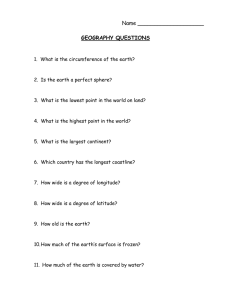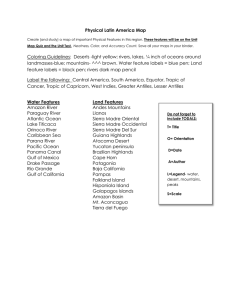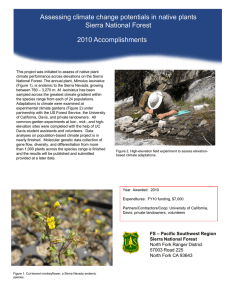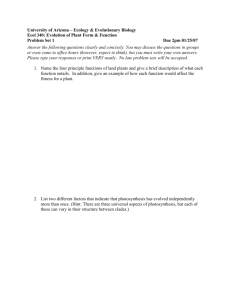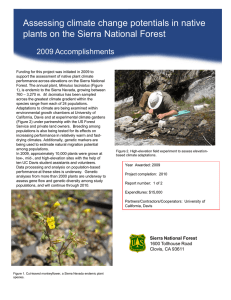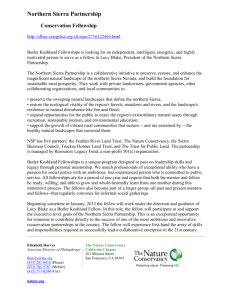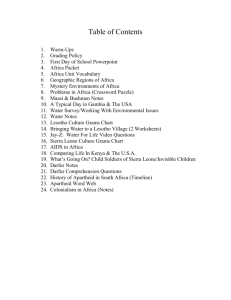Comparison of the Tropical Floras of the Sierra la Madera
advertisement
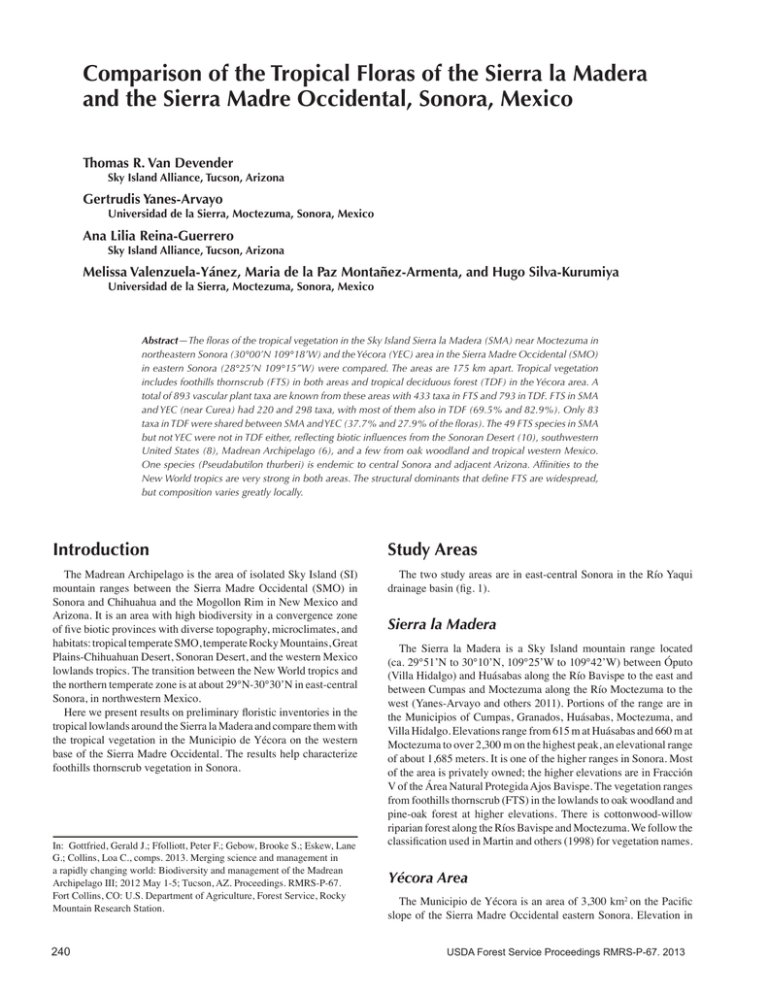
Comparison of the Tropical Floras of the Sierra la Madera and the Sierra Madre Occidental, Sonora, Mexico Thomas R. Van Devender Sky Island Alliance, Tucson, Arizona Gertrudis Yanes-Arvayo Universidad de la Sierra, Moctezuma, Sonora, Mexico Ana Lilia Reina-Guerrero Sky Island Alliance, Tucson, Arizona Melissa Valenzuela-Yánez, Maria de la Paz Montañez-Armenta, and Hugo Silva-Kurumiya Universidad de la Sierra, Moctezuma, Sonora, Mexico Abstract—The floras of the tropical vegetation in the Sky Island Sierra la Madera (SMA) near Moctezuma in northeastern Sonora (30°00’N 109°18’W) and the Yécora (YEC) area in the Sierra Madre Occidental (SMO) in eastern Sonora (28°25’N 109°15”W) were compared. The areas are 175 km apart. Tropical vegetation includes foothills thornscrub (FTS) in both areas and tropical deciduous forest (TDF) in the Yécora area. A total of 893 vascular plant taxa are known from these areas with 433 taxa in FTS and 793 in TDF. FTS in SMA and YEC (near Curea) had 220 and 298 taxa, with most of them also in TDF (69.5% and 82.9%). Only 83 taxa in TDF were shared between SMA and YEC (37.7% and 27.9% of the floras). The 49 FTS species in SMA but not YEC were not in TDF either, reflecting biotic influences from the Sonoran Desert (10), southwestern United States (8), Madrean Archipelago (6), and a few from oak woodland and tropical western Mexico. One species (Pseudabutilon thurberi) is endemic to central Sonora and adjacent Arizona. Affinities to the New World tropics are very strong in both areas. The structural dominants that define FTS are widespread, but composition varies greatly locally. Introduction Study Areas The Madrean Archipelago is the area of isolated Sky Island (SI) mountain ranges between the Sierra Madre Occidental (SMO) in Sonora and Chihuahua and the Mogollon Rim in New Mexico and Arizona. It is an area with high biodiversity in a convergence zone of five biotic provinces with diverse topography, microclimates, and habitats: tropical temperate SMO, temperate Rocky Mountains, Great Plains-Chihuahuan Desert, Sonoran Desert, and the western Mexico lowlands tropics. The transition between the New World tropics and the northern temperate zone is at about 29°N-30°30’N in east-central Sonora, in northwestern Mexico. Here we present results on preliminary floristic inventories in the tropical lowlands around the Sierra la Madera and compare them with the tropical vegetation in the Municipio de Yécora on the western base of the Sierra Madre Occidental. The results help characterize foothills thornscrub vegetation in Sonora. The two study areas are in east-central Sonora in the Río Yaqui drainage basin (fig. 1). In: Gottfried, Gerald J.; Ffolliott, Peter F.; Gebow, Brooke S.; Eskew, Lane G.; Collins, Loa C., comps. 2013. Merging science and management in a rapidly changing world: Biodiversity and management of the Madrean Archipelago III; 2012 May 1-5; Tucson, AZ. Proceedings. RMRS-P-67. Fort Collins, CO: U.S. Department of Agriculture, Forest Service, Rocky Mountain Research Station. 240 Sierra la Madera The Sierra la Madera is a Sky Island mountain range located (ca. 29°51’N to 30°10’N, 109°25’W to 109°42’W) between Óputo (Villa Hidalgo) and Huásabas along the Río Bavispe to the east and between Cumpas and Moctezuma along the Río Moctezuma to the west (Yanes-Arvayo and others 2011). Portions of the range are in the Municipios of Cumpas, Granados, Huásabas, Moctezuma, and Villa Hidalgo. Elevations range from 615 m at Huásabas and 660 m at Moctezuma to over 2,300 m on the highest peak, an elevational range of about 1,685 meters. It is one of the higher ranges in Sonora. Most of the area is privately owned; the higher elevations are in Fracción V of the Área Natural Protegida Ajos Bavispe. The vegetation ranges from foothills thornscrub (FTS) in the lowlands to oak woodland and pine-oak forest at higher elevations. There is cottonwood-willow riparian forest along the Ríos Bavispe and Moctezuma. We follow the classification used in Martin and others (1998) for vegetation names. Yécora Area The Municipio de Yécora is an area of 3,300 km2 on the Pacific slope of the Sierra Madre Occidental eastern Sonora. Elevation in USDA Forest Service Proceedings RMRS-P-67. 2013 Comparison of the Tropical Floras of the Sierra la Madera and the Sierra Madre . . . Van Devender and others at UNISIERRA collected plants in the Ejido de Tonibabi area east of Moctezuma on eight trips in April-December 2011. Plant collections were deposited into the Universidad de Sonora (USON), University of Arizona (ARIZ), and other herbaria. All plant observations and collections, and many images are available online in the MABA database (madrean.org). Results Figure 1—Study areas. the Municipio ranges from 480 m near Curea to 2,140 m on Mesa del Campanero, an increase of 1,660 meters in 27 km (by air). Mexican Federal Highway 16 (MEX 16) is one of the few highways that crosses the SMO, providing a west-east elevational transect from foothills thornscrub near Curea (460-550 m) and tropical deciduous forest (TDF, 500-1,160 m) up through oak woodland (1,050-1,700 m) to pine-oak forest (1,220-2,240 m). Grassland occurs in high valleys (1,200-1,700 m) within oak woodland or pine-oak forest. Mixed-conifer forest (1,900-2,100 m) is present in Barranca El Salto on Mesa del Campanero. Inventories The Universidad de la Sierra (UNISIERRA) in Moctezuma has a long-term project to document the flora of Sierra la Madera (YanesArvayo and others 2011). Only a few plants were collected in this area before the floristic efforts summarized here. The Lumholtz Expedition to the Sierra Madre Occidental followed the Río Bavispe from Óputo (Villa Hidalgo) to Huásabas and Granados in September-October 1890 (Lumholtz, 1902). The Swedish botanist Carl V. Hartman, on the Expedition, collected plants along the eastern base of the Sierra la Madera. Stephen S. White of the University of Michigan visited the Moctezuma area in 1938 as part of his floristic study of the Río Bavispe region in northeastern Sonora (White, 1948). Stephen S. Hale made a few noteworthy collections in a survey of the Tarahumara frog (Rana tarahumarae) in 1981 (Hale and May, 1983). In August 2010, the Madrean Archipelago Biodiversity (MABA) Project led an expedition to the Sierra la Madera. A group of 38 scientists, researchers, students, volunteers, and Comisión Nacional de Áreas Naturales Protegidas (CONANP) made biological observations, plant collections, and images at ranchos la Barchata, las Bateas, la Cieneguita (and areas above), Mesa Quemada, and San Fernando. In September 2011, Van Devender and Reina-Guerrero observed the flora on the east slope of the Sierra la Madera west of Huásabas. Melissa Valenzuela-Yánez (2012) as part of her undergraduate thesis USDA Forest Service Proceedings RMRS-P-67. 2013 We documented 220 taxa in 57 families in FTS in the Sierra la Madera. The families with the most species are Fabaceae (16.4%), Asteraceae (11.4%), Poaceae (5.9%), and Cactaceae and Malvaceae (4.5% each). The genera with the most species are Acacia, Euphorbia, and Ipomoea (6 taxa each), and Bouteloua (5 taxa). Only seven species are non-native (3.2%): i.e., Cynodon dactylon, Marrubium vulgare, Melinis repens, Mollugo verticillata, Nasturtium officinale, Nicotiana glauca, and Pennisetum ciliare. Only P. ciliare (buffelgrass) is invasive in FTS, although berro (N. officinale) can be very common in permanent streams. The life forms of the Sierra la Madera FTS flora are herbs (53.2%, including grasses and sedges), woody plants (40.9%), and succulents (5.5%). The herbs (103 taxa) are nearly equally perennial (54 taxa) and annual (49 taxa), with only 14 grass/ sedge taxa. It is clear that there needs to be additional documentation of annuals and grasses. Although the larger woody plants and succulents are the structural dominants in FTS, their life forms are not as common as herbs: i.e., trees (10.5%), shrubs (15.9%), and subshrubs (8.7%). The floristic affinities of the Sierra la Madera FTS are mostly tropical. Of the 49 species in the Sierra la Madera FTS that were not in Yécora FTS or TDF, 43 are native, terrestrial species. Most of them occur in the Sonoran Desert and/or desert grassland (30 each), or are widespread from the Sonoran Desert through desert grasslands to western Texas (16 species), with a total of 36 species (83.7%) in this group. The affinities are less strong with the SMO/SI (7 taxa). In the Yécora area, we documented 298 taxa in 61 families in the FTS flora. The families with the most species are Fabaceae (11.7%), Asteraceae and Poaceae (10.1% each), Euphorbiaceae (5.4%), and Convolvulaceae (4.7%). The genera with the most species are Ipomoea (10), Euphorbia (9), Physalis (6), and Cyperus and Muhlenbergia (5 each). There are 24 non-native species (8.0%). The life forms of the Yécora area thornscrub flora are herbs (68.8%), woody plants (29.5%), and succulents (2.0%). Twice as many herbs are annuals (111 taxa) as perennials (57 taxa). Annuals and grasses/sedges (37 taxa) are better represented than in the Sierra la Madera. Trees (7.4%), shrubs (11.4%), and subshrubs (7.0%) are the structural dominants. Discussion The flora of FTS has not previously been studied. We identified 220 plant taxa in FTS in the Sierra la Madera and 298 taxa in the Yécora (35% richer), with 433 taxa in both areas. Most FTS species also occur in TDF in the Yécora area (69.5% and 82.9% of the floras), which, with 793 taxa, is much more diverse than FTS. But as pointed out by Rzedowski (1978) for the Sierra Madre Occidental in general, oak woodland (809) and pine-oak forest (1081) at higher elevations on the Yécora gradient are more diverse than tropical lowland communities (Van Devender and Reina-Guerrero, unpublished). Floristically, there are 83 taxa shared between the Sierra la Madera and Yécora FTS floras (37.7% and 27.9%, respectively). The differences between FTS in the Sierra la Madera and the Yécora area are mostly in herbs. The numbers of structurally dominant woody plants 241 Van Devender and others in the two FTS floras are remarkably similar; i.e., trees (23, 24 taxa), shrubs (35, 34 taxa), subshrubs (19, 21 taxa), and woody vines (12, 11 taxa). Important FTS trees are Acacia occidentalis, Bursera fagaroides, B. laxiflora, Fouquieria macdougalii, Ipomoea arborescens, Jatropha cordata, Lysiloma watsonii, and Parkinsonia praecox, plus the shrubs Erythrina flabelliformis, Eysenhardtia orthocarpa, and Mimosa distachya. Woody vines with 20 species are much more diverse in TDF than FTS, and steadily decline to the west as aridity increases in the Sonoran Desert. Deep History of Thornscrub The uplift of the Sierra Madre Occidental (SMO) in the late Oligocene-middle Miocene (25-15 million years ago, mya) had dramatic impacts on the biota of northwestern Mexico (Van Devender, 2002). Tropical forests, once found from coast-coast across the continent, were restricted to the coastal lowlands. As the region gradually dried out in the Miocene, tropical deciduous forest isolated in northwestern Mexico was transformed first into thornscrub and then into desertscrub, as the Sonoran Desert formed about 8 million years ago (Axelrod, 1979). In the Pliocene (2.4-5 mya), there was a reversal to more tropical climates, when thornscrub presumably expanded back into desert areas. The climatic changes during the Pleistocene with 15-20 glacial/ interglacial climatic cycles had dramatic impacts on the Sonoran Desert as pinyon-juniper woodlands moved to low elevations in southwestern Arizona and southeastern California (Van Devender, 1990). Ice age climates differed from modern ones in much cooler summers, fewer winter freezes, reduced summer rains from tropical oceans, and increased winter precipitation from Pacific frontal storms. For 80-90% of the last two million years, the Sonoran Desert was greatly reduced in area, but thornscrub may have expanded as TDF dried out to the south. Thornscrub There are two types of thornscrub in Sonora (Martin and others 1998). Coastal thornscrub is on the flat coastal plain of the Gulf of California from Empalme-Guaymas southward (Friedman 1996). Foothills thornscrub is on inland rocky slopes. In southern Sonora, FTS is below TDF in elevation. In central Sonora, it is the transitional vegetation between the Plains of Sonora subdivision Sonoran desertscrub on the west and oak woodland in Sky Island mountain ranges and the Sierra Madre Occidental to the east. In the north, FTS is replaced by desert grassland as winters become colder and periodic fires become ecological processes. The northern limits of FTS in Sonora are at about 30°11’N east of Sinoquipe in the Río Sonora Valley and 30°26’N at Presa Angostura on the Río Bavispe at the southern end of the Sierra El Tigre. FTS does not reach Arizona, but the distributions of quite a few FTS species cross the border into southern Arizona in desert grassland or oak woodland. We conclude that foothills thornscrub is a distinct vegetation type that evolved in northwestern Mexico and is best represented in Sonora, Comparison of the Tropical Floras of the Sierra la Madera and the Sierra Madre . . . where it is widespread, important, and under-appreciated. Our findings suggest that the floristic composition of FTS varies in different areas, but similarities in community structure (height, strata, and density) and dominants, habitats, and climate make it readily recognizable. Acknowledgments Father William Trauba, Thomas F. Daniel, Patty West, and Kim Baker helped with the fieldwork in the Yécora area. We thank Don Pedro Avilez, Don Francisco Encinas, Doña Rosa, and Yaneth of Curea for guidance and hospitality. We thank Sky Island Alliance and the Universidad de la Sierra for support of the MABA Expedition to the Sierra de la Madera. We thank John A. Anderson for his careful review of the paper. References Axelrod, Daniel I. 1979. Age and origin of the Sonoran Desert. California Academy of Sciences. Occasional Papers, 132: 1-74. Friedman, Samuel. L. 1996. Vegetation and flora of the coastal plains of the Río Mayo region, southern Sonora, Mexico. M.S. Thesis. Tempe: Arizona State University. Hale, Stephen F.; and May, Clarence. J. 1983. Status Report for Rana tarahumarae Boulenger. Arizona Natural Heritage Program, Tucson. Report to Office of Endangered Species, U.S. Fish and Wildlife Service, Albuquerque, NM. 99 p. Lumholtz, Carl S. 1902. Unknown Mexico: A record of five years’ exploration among the tribes of the western Sierra Madre; in the Tierra Caliente of Tepic and Jalisco; and among the Tarascos of Michoacán. New York: Charles Scribner’s Sons. Martin, Paul S.; Yetman, David A.; Fishbein, Mark; [and others]. (eds.). 1998. Gentry’s Río Mayo Plants. The tropical deciduous forest and environs of northwest Mexico. Tucson: University of Arizona Press. 558 p. Rzedowski, J. 1978. Vegetación de México. México: Editorial Limusa. 432 p. Van Devender, Thomas R. 1990. Late Quaternary vegetation and climate of the Sonoran Desert, United States and Mexico. Pp. 134-165 in Betancourt, Julio L.; Van Devender, Thomas R.; and Martin, Paul S. eds. Packrat Middens. The Last 40,000 Years of Biotic Change. Tucson: University of Arizona Press. 467 p. Van Devender, Thomas R. 2002. Environmental history of the Sonoran Desert. Pp. 3-24 in Fleming, Theodore H.; and Valiente-Banuet, Alfonso. eds. Evolution, Ecology and Conservation of Columnar Cacti and their Mutualists. Tucson: University of Arizona Press. 371 p. Valenzuela-Yánez, Melissa. 2012. Flora vascular del Ejido Tonibabi; Moctezuma, Sonora. Memoria Professional para Licenciado en Biología, Universidad de la Sierra, Moctezuma, Sonora. 62 p. White, Stephen S. 1948. The vegetation of flora of the region of the Río de Bavispe in northeastern Sonora, Mexico. Lloydia, 11: 229‑302. Yanes-Arvayo, Gertrudis; Montañez-Armenta, María de la Paz; Silva-Kurumiya, Hugo; Gil-Montaño, Enrique; Van Devender, Thomas R.; and ReinaGuererro, Ana L. 2011. Catálogo de Plantas de Sierra La Madera. Arbóreas, Arbustivas y Herbáceas. Universidad de la Sierra, Hermosillo, Sonora. The content of this paper reflects the views of the authors, who are responsible for the facts and accuracy of the information presented herein. 242 USDA Forest Service Proceedings RMRS-P-67. 2013
